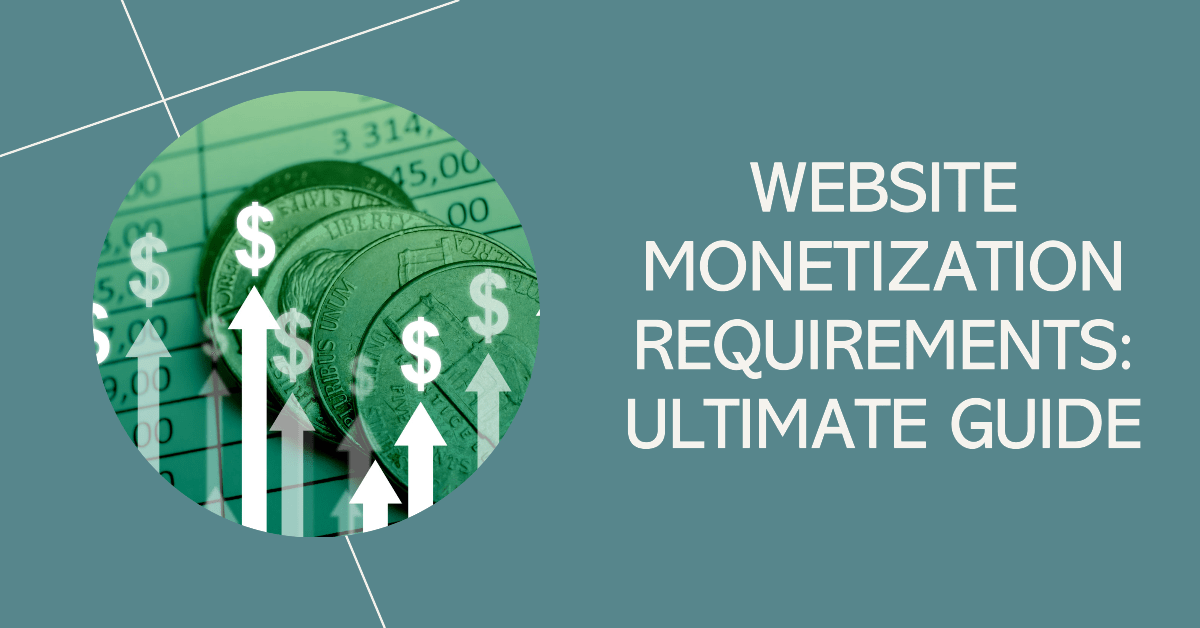So, you’ve built a fantastic website that’s attracting quite a bit of traffic, and now you’re thinking – how can I make some money out of this?
Well, my friend, you’re in luck because this article is here to guide you through the ins and outs of website monetization requirements.
Whether you’re planning on using ads, sponsored content, or affiliate marketing, understanding the guidelines and criteria for monetizing your website is crucial.
From quality content and user experience to traffic thresholds and compliance rules, we’ll cover all the essentials to ensure you’re on the right track to turning your website into a profitable enterprise.
Website Monetization Requirements: A Comprehensive Guide

1. Website Monetization Requirements: Ad Network Requirements
1.1. Traffic
When it comes to monetizing your website through ads, one of the most crucial factors is the amount of traffic your site receives. Ad networks typically require a minimum level of monthly page views or unique visitors before approving your website for ad placement. These requirements vary across different ad networks, so it’s essential to research and find the ad network that aligns with your website’s current traffic levels.
1.2. Content
The content on your website plays a significant role in attracting advertisers and determining the type of ads you can display. Ad networks often have specific content guidelines that your website must adhere to. It’s important to ensure that your website offers original and unique content that is relevant to your target audience. High-quality content not only attracts more advertisers but also increases user engagement, leading to higher ad revenue.
1.3. Website Design and User Experience
The design and user experience of your website greatly impact the effectiveness of ads and the overall user satisfaction. Ad networks typically look for well-designed websites that prioritize user experience. A cluttered and confusing website layout can frustrate users and diminish the impact of ads. Make sure your website has intuitive navigation, fast loading times, and a responsive design that adapts seamlessly to different devices.
1.4. Compliance and Legal
Ad networks have strict compliance and legal requirements that you must meet to ensure a safe and trustworthy advertising environment. It’s crucial to review the ad network’s policies and guidelines to ensure your website complies with their rules. This includes avoiding prohibited content such as adult or explicit material, misleading content, and copyrighted material. Non-compliance can result in your website being banned from the ad network and potential legal implications.
1.5. Minimum Traffic Thresholds
In addition to general traffic requirements, some ad networks may have specific minimum traffic thresholds for different regions or countries. This is especially true for international ad networks that cater to specific markets. It’s important to be aware of these thresholds and ensure that your website meets the minimum traffic requirements for the regions you are targeting.
Related: Is Google AdSense Worth It?
2. Website Monetization Requirements: Ad Placement and Optimization Guidelines

2.1. Ad Placement
Placing ads strategically on your website is crucial for maximizing revenue without compromising user experience. Ad networks often provide guidelines on where to place ads for optimum visibility and engagement. Popular ad placements include above the fold, within the content, and at the end of articles. However, it’s important to strike a balance between ad placement and user experience to avoid overwhelming visitors with excessive ads.
2.2. Ad Formats
Ad networks offer various ad formats to choose from, including display ads, native ads, video ads, and more. It’s important to select ad formats that align with your website’s design and content. Native ads, for example, blend seamlessly with your website’s layout, providing a more organic user experience. Experimenting with different ad formats can help you find the ones that perform best on your website and generate higher click-through rates.
2.3. Ad Optimization Techniques
To maximize ad revenue, it’s important to optimize ad performance through techniques such as A/B testing, ad refresh, and ad targeting. A/B testing involves creating different versions of ads or ad placements and comparing their performance to identify the most effective ones. Ad refresh is the process of automatically reloading ads after a certain period to increase visibility and engagement. Ad targeting allows you to display ads based on user demographics and interests, increasing the chances of clicks and conversions.
2.4. User Experience
While generating ad revenue is important, it should never come at the expense of a positive user experience. Excessive or intrusive ads can lead to a poor user experience and drive visitors away from your website. Strive for a balance between generating revenue and providing a seamless user experience. Consider using ad blockers on your own website to understand how ads are impacting the user experience and make adjustments accordingly.
2.5. Ad Refreshing Policies
Ad networks often have specific policies regarding ad refreshing, including how frequently ads can be refreshed and the duration between each refresh. It’s important to understand and comply with these policies to avoid violating ad network guidelines or facing penalties. Ad refreshing can help increase ad visibility and engagement, but it must be done in moderation to ensure a positive user experience.
3. Website Monetization Requirements: Mobile Responsiveness

3.1. Mobile-Friendly Design
In today’s mobile-centric world, having a mobile-friendly website is crucial for successful ad monetization. Ad networks prioritize websites that have responsive designs, ensuring that your website adapts seamlessly to different screen sizes and devices. A mobile-friendly design not only improves user experience but also increases the potential reach and effectiveness of mobile ads.
3.2. Responsive Ad Formats
Just like your website design, the ad formats you choose should be responsive and suitable for mobile devices. Mobile ad formats, such as interstitial ads or mobile-specific banner ads, can be used to optimize ad placement and visibility on small screens. It’s important to test how ads appear on mobile devices and make adjustments as needed to ensure a seamless user experience.
3.3. Mobile Ad Placement
Placing ads effectively on mobile devices requires a different approach compared to desktop websites. Mobile users are often engaged in vertical scrolling, so it’s important to utilize ad placements that align with their natural scrolling behavior. Sticky ads that remain at the top or bottom of the screen as users navigate can capture attention without being obtrusive, while in-line ads within content can provide a seamless ad experience.
3.4. Mobile User Experience
Mobile user experience should be a top priority when monetizing your website with ads. Slow loading times, intrusive ads, or a cluttered layout can negatively impact user experience on mobile devices. Optimize your website for speed, minimize the number of ads displayed on mobile screens, and ensure ads do not obstruct content or interrupt the user’s natural flow. Providing a smooth and enjoyable user experience on mobile will contribute to higher ad engagement and revenue.
4. Website Monetization Requirements: Site Speed

4.1. Page Load Time
Site speed has a significant impact on user experience, search engine rankings, and ad performance. Slow-loading websites frustrate users and result in higher bounce rates. Ad networks often prioritize websites with fast page load times since it ensures a positive user experience and optimizes ad visibility. Regularly monitor and optimize your website’s performance by minimizing HTTP requests, optimizing code, and leveraging caching techniques.
4.2. Caching
Caching plays a crucial role in improving site speed and overall performance. By storing static versions of your website’s content, caching reduces the amount of processing and data retrieval required for each user request. Implementing caching techniques, such as browser caching and server-side caching, can significantly improve your website’s loading times and enhance the user experience while browsing your site.
4.3. Image Optimization
Images are an integral part of website design but can also contribute to slow loading times if not optimized. Compressing images, using proper file formats, and providing dimensions that match the container size can help reduce image file sizes without compromising quality. Optimized images improve website performance, including the loading speed of ads that rely on visual elements.
4.4. Code Minification
Excessively large or unoptimized code can slow down your website’s loading times. Code minification involves removing unnecessary characters, spaces, and comments without changing its functionality. This process reduces the file size of your code, resulting in faster loading times. Consider minifying your HTML, CSS, and JavaScript code to optimize your website’s performance and ensure ads load quickly.
4.5. Content Delivery Network (CDN)
Implementing a Content Delivery Network (CDN) can significantly improve the speed and performance of your website, especially for users located far from your server’s geographical location. A CDN distributes your website’s content across multiple servers worldwide, delivering it to users from the server closest to their location. This reduces latency and improves loading times for all website elements, including ads.

5. Website Monetization Requirements: Content Quality and Compliance
5.1. Original and Unique Content
High-quality and unique content is not only crucial for attracting visitors but also for maintaining a positive relationship with ad networks. Ad networks value websites that offer original and valuable content to their audience. Plagiarized or duplicate content can lead to penalization or rejection by ad networks. Ensure that your content is engaging, well-researched, and tailored to your target audience.
5.2. Prohibited Content
Ad networks have strict guidelines regarding prohibited content. It’s important to review these guidelines and ensure your website complies with the ad network’s policies. Common prohibited content includes illegal or harmful activities, violent or hateful content, and deceptive or misleading information. Make sure your website’s content aligns with ethical standards and respects the guidelines set by the ad network.
5.3. Copyrighted Material
Using copyrighted material without proper authorization can result in legal consequences and damage your website’s reputation with ad networks. Avoid using copyrighted images, videos, or text without obtaining the necessary permissions or licenses. Create and publish original content, or use content from reputable sources with proper attribution to ensure compliance with copyright laws.
5.4. Adult or Explicit Content
Displaying adult or explicit content can severely limit your options for ad monetization. Most ad networks have strict policies against adult content due to its potential to offend or harm users. If your website deals with mature or sensitive content, consider alternative monetization methods that are specifically tailored to adult-oriented websites.
5.5. Clickbait and Misleading Content
Clickbait articles or misleading content may attract initial clicks, but they lead to a negative user experience and damage your website’s reputation in the long run. Ad networks value websites that provide honest and accurate content to ensure trust and authenticity for their advertisers. Focus on creating content that delivers on its promises and offers genuine value to your audience.
5.6. Compliance with Advertising Policies
To ensure monetization success, it’s crucial to comply with the specific advertising policies and guidelines set by your chosen ad networks. Ad networks have their own set of rules regarding ad placement, ad content, and user experience. Failure to comply with these policies can result in account suspension, loss of revenue, or even termination of partnership. Regularly review the ad network’s policies and adjust your website accordingly to maintain compliance.
6. Website Monetization Requirements: Analytical and Tracking Tools

6.1. Google Analytics Integration
Integrating Google Analytics into your website provides invaluable insights into user behavior and ad performance. Google Analytics helps you track important metrics such as page views, bounce rates, and conversion rates. By understanding user behavior and engagement patterns, you can optimize your ad placement and content to generate better ad revenue.
6.2. Conversion Tracking
Tracking conversions is essential for understanding the effectiveness of your ads and optimizing your ad strategy. Use conversion tracking tools to measure how many users take desired actions, such as making a purchase or signing up for a newsletter, after clicking on an ad. This information helps you evaluate the performance of different ad campaigns and make data-driven decisions to maximize conversions and revenue.
6.3. User Behavior Analysis
Analyzing user behavior on your website helps you identify patterns, preferences, and pain points. Heatmap tools, for example, visualize user interactions and show you which areas of your website attract the most attention. Understanding user behavior allows you to optimize ad placement and design to improve engagement, click-through rates, and overall user experience.
6.4. Ad Performance Tracking
Measuring ad performance is crucial to ensure you are generating optimal revenue. Ad networks often provide their own tracking tools and dashboards to help you monitor the performance of your ads. These tools provide insights into impression rates, click-through rates, and revenue generated by each ad placement. Regularly analyze these metrics to identify underperforming ads and optimize their positioning or format for better results.
6.5. A/B Testing
A/B testing, also known as split testing, involves comparing two versions of a webpage or an ad to determine which one performs better. By creating two variants and measuring their performance, you can make data-driven decisions and optimize your website for higher ad revenue. Test different ad placements, formats, and content to discover the combinations that generate the best results.

7. Website Monetization Requirements: Traffic Sources and Referral Guidelines
7.1. Organic Search Traffic
Organic search traffic refers to visitors who find your website through search engines like Google or Bing. This type of traffic is highly valuable for ad monetization since users actively search for specific information or products. Optimizing your website for search engines through search engine optimization (SEO) techniques can increase organic search traffic, resulting in higher ad impressions and potential revenue.
7.2. Social Media Traffic
Social media platforms provide a valuable avenue for driving traffic to your website and increasing ad monetization opportunities. By leveraging social media marketing strategies, you can attract a larger audience and direct them to your website. Engage with your followers, share relevant content, and promote your website’s value proposition to drive social media traffic that boosts ad impressions and click-through rates.
7.3. Direct Traffic
Direct traffic occurs when users directly type your website URL into their web browser or click on a bookmarked link. This traffic source often represents loyal users or those who are already familiar with your brand. Encourage direct traffic by building brand awareness, providing a memorable user experience, and offering valuable content. Direct traffic is particularly valuable for ad revenue since these users are likely to engage with and convert on your website.
7.4. Referral Traffic
Referral traffic refers to visitors who come to your website through external sources such as other websites, blogs, or online directories. Building strong relationships with reputable websites in your niche can drive valuable referral traffic and increase your website’s visibility. Guest posting, backlink building, and participating in relevant online communities can help you attract referral traffic, expanding your ad monetization potential.
7.5. Paid Traffic
Paid traffic involves running paid advertising campaigns to drive visitors to your website. From search engine ads to social media ads, paid traffic can produce immediate and targeted visitors to your website. However, it’s important to carefully manage your advertising budget and optimize your campaigns to ensure a positive return on investment (ROI) and maximize ad revenue from paid traffic sources.
8. Monetizing a Website: User Data and Privacy Compliance
8.1. Data Collection and Consent
Collecting user data is a common practice for website owners, but it must be done in compliance with privacy regulations and user consent. Ensure that your data collection processes are transparent, and users have the option to provide consent or opt-out of data sharing. Clearly communicate your data collection practices in your privacy policy and provide users with control over their personal information.
8.2. Cookie Policies
Cookies are used to track user behavior and provide a personalized browsing experience. Make sure your website has a clear and up-to-date cookie policy that complies with relevant regulations, such as the European Union’s General Data Protection Regulation (GDPR). Inform users about the use of cookies on your website, including the purposes, types, and duration of cookies, and provide the option for users to accept or reject cookies.
8.3. GDPR and Privacy Laws
If your website targets users in the European Union, it’s essential to comply with the GDPR and other applicable privacy laws. These regulations govern how personal data is processed, stored, and protected. Familiarize yourself with the GDPR requirements, such as obtaining user consent for data processing, implementing appropriate security measures, and adhering to guidelines for data retention and breach notifications.
8.4. Personal Information Handling
Safeguarding personal information is crucial for maintaining user trust and complying with privacy regulations. Implement proper security protocols to protect user data from unauthorized access or breaches. Minimize the amount of personally identifiable information collected and stored, and regularly review your data management practices to ensure compliance with privacy laws and industry best practices.
9. Monetize Your Blog: Advertiser Requirements
9.1. Advertiser Relevance
To attract high-quality advertisers, your website must be relevant to their target audience. Advertisers seek websites that align with their products or services, ensuring their ads reach the right audience. Continuously create and publish content that is relevant to your target audience, increasing the likelihood of attracting advertisers who value your niche and are willing to pay for ad space on your website.
9.2. Advertiser Reputation
Working with reputable and trustworthy advertisers is important for maintaining a positive user experience and protecting your website’s reputation. Research potential advertisers, review their website, products, and customer reviews to ensure they align with your values and meet your standards. Partnering with reputable advertisers enhances user trust and increases the chances of long-term collaborations.
9.3. Brand Safety
Ad networks prioritize brand safety and ensure that ads are not associated with harmful, illegal, or misleading content. As a website owner, it’s crucial to maintain brand safety on your website. Regularly review ad placements and content to minimize the risk of displaying ads alongside inappropriate or unethical content. Protecting your website’s brand safety helps attract credible advertisers and improves user trust.
9.4. Advertiser Vetting
To protect your website and users from potential scams or fraudulent activities, it’s important to vet potential advertisers before partnering with them. Research their reputation, reviews, and conduct due diligence to ensure they meet your standards. Verify their legitimacy, website quality, and payment terms to mitigate risks and avoid collaborating with unreliable or unethical partners.
9.5. Advertiser Payment Terms
Understanding payment terms and expectations is vital when partnering with advertisers. Clarify payment terms upfront, including payment schedules, payment methods, and any other relevant financial arrangements. Ad networks often provide guidelines regarding payment terms, but it’s essential to negotiate and establish clear communication channels with advertisers to ensure a smooth and transparent monetary transaction process.
10. Website Monetization Guidelines: Ad Fraud Prevention
10.1. Invalid Traffic Detection
Ad fraud poses a significant threat to the effectiveness and legitimacy of ad monetization. Implement measures to detect and prevent invalid or fraudulent traffic, such as bot traffic or click fraud. Invest in fraud detection tools and regularly monitor traffic patterns, clicks, and conversions to identify suspicious activities. By detecting and addressing ad fraud, you can protect your website’s integrity and maintain trust with both users and advertisers.
10.2. Ad Verification Tools
Ad verification tools help ensure that ads are displayed accurately and meet the desired specifications. These tools verify ad placements, ad content, and compliance with industry guidelines. Utilize such tools to minimize the risk of displaying inappropriate or non-compliant ads, ensuring a safe and trustworthy advertising environment on your website.
10.3. Bot Filtering
Bots can generate fake ad impressions or clicks, leading to inaccurate reporting and wasted ad budget. Implement bot filtering techniques to detect and filter out bot traffic. Utilize anti-bot tools, work closely with your ad network to implement additional bot detection measures, and monitor traffic patterns to identify any suspicious behavior. By reducing bot traffic, you can optimize your ad revenue by ensuring legitimate engagement and advertising metrics.
10.4. Click Fraud Detection
Click fraud involves clicking on ads with the intent to generate revenue or exhaust an advertiser’s budget. Regularly monitor and analyze click patterns to identify any unusual activity. Implement click fraud detection tools to automatically identify suspicious patterns and block or invalidate fraudulent clicks. By reducing click fraud, you can improve ad performance and maintain trusted relationships with your advertisers.
10.5. Viewability Monitoring
Viewability monitoring ensures that ads are visible to users and not hidden or obstructed by other website elements. Utilize viewability monitoring tools to measure the percentage of ad impressions that are viewable to users. Monitor ad placements, user scrolling behavior, and engagement rates to optimize viewability and generate more revenue from truly visible and valuable ad impressions.
Congratulations! You’ve reached the end of our comprehensive guide to ad network requirements and best practices for website monetization. By following these guidelines and implementing the recommended techniques, you can optimize your website for ad placement, improve user experience, and maximize your ad revenue potential. Remember to regularly review and adapt your monetization strategy to stay up-to-date with changing industry trends and regulations.
You May Also Like: How to Make Money with Maxbounty



